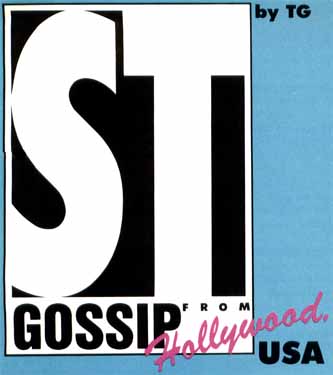
The
"New" ST
During a recent phone conversation with a friend who
has some inside lines to Atari Corp., I learned that Atari has a new ST
model waiting in the wings. My first reaction to this news was to
wonder how Atari could possibly think of adding yet another model to a
line that already contains so many machines (the 520, 1040, Megas,
Stacy). The word from the top seems to be that this new ST model will
replace several if not all of the current machines (except the Stacy).
This machine has been called the EST and ST+, but my sources tell me
the real name Atari uses is the "STE" (E for "Extended" or "Enhanced").Although the exterior form of this machine hasn't been made final yet, the internals have. A number of changes make the STE a better machine than any of the current ST models. First, the mouse/joystick ports can now be used for output, something the old 8-bit Ataris could do that the ST couldn't. Second, Atari has managed to crunch down the number of parts again. Word is that the MMU and GLU circuits are now contained in one chip.
Of more importance to the average user, the video chip has been modified to support 16 levels for each of the RGB settings, rather than the eight levels of older STs. This means the total palette has been expanded from 512 colors to a more desirable 4,096 colors. This should encourage software developers to provide support for this larger palette, which may also help people who have installed color-upgrade boards into their current STs.
Sound has long been the Achilles' heel of the ST computers. The ST's sound chip is a relatively old one that pales in comparison to the sound hardware of computers like the Amiga and Apple IIGS. The STE addresses this problem through its inclusion of a new sound chip that provides much better audio via stereo output. This chip is not the AMY sound chip that Atari had announced four years ago. Apparently, AMY is still bogged down in a technical and legal quagmire.
Word from sources close to Atari indicate that the current plan is to release a single STE model. This machine will be configured much like a 1040ST and contain one double-sided microfloppy drive and one megabyte of RAM. For those who need or want more memory, the STE allows this by providing plug-in connectors for SIM (Single Inline Memory) modules (such as are used in some Macintosh models). In this way, users can easily add RAM just by plugging it in, eliminating the need for hardware hacking.
And, in spite of all rumors to the contrary, the STE will not feature a 68020 microprocessor. It will contain the same 8-MHz MC68000 processor that all other STs have.
In light of this, it seems reasonable to assume that Atari will discontinue production of the current 520ST and 1040ST models. Not to worry, though. Atari is working hard to make sure the STE is completely compatible with the current ST. When running normal ST software, the STE will act like any of the current models. It will only perform differently when STEspecific instructions are sent to it.
TOS
1.6 and Up?
At this writing, the ROM version of the long-awaited
TOS 1.4 is only available to licensed ST developers, and the general ST
public is still waiting for this upgrade. But, even as users
impatiently await the release of TOS 1.4, Atari is working on further
revisions.Many ST users who have gotten wind of this rumored TOS 1.6 have become upset, feeling that by the time they can get 1.4, Atari will be ready to replace it. Well, the word I have gotten is that these further TOS upgrades aren't specifically for the ST. The upgrading is part of an ongoing development process aimed at new machines coming down the pike, such as the 68030 TT machine. Sources I spoke to at Atari indicated that they have never been happy with certain aspects of TOS, and not particularly with the version of the GEM Desktop contained in the ST's operating system. In light of user comments and Atari's own feelings, it was decided to improve things for future machines.
The source code for these future versions of TOS is being written in a non-compiler-specific form, which will allow TOS to be ported and compiled in C compilers other than Atari's own Alycon C, which all current versions of TOS are written specifically for. This will allow TOS to be ported to new machines and processors more easily (without first having to await Alycon C to be converted).
As to the GEM Desktop, taking the cue from users and from third-party software developers who have "added" features to GEM, Atari is looking to incorporate some of these new and improved ideas to make the Desktop easier to work with. One source at Atari has hinted that a mock-up of the new Desktop is in the works, and that while current GEM users will find it instantly familiar, they will also discover it is easier to use and more intuitive.
The
68030 TT
My sources tell me that, yes, the TT does exist. The
TT is the next-generation machine beyond the current ST models, and as
such is much faster and more powerful, capable and expandable than any
ST or even the STE.The TT's heart is a 16-MHz 68030 microprocessor. This pure 32-bit chip is many times faster and can directly address more memory than the 68000 microprocessor used in the ST. With a caching program installed, the TT is rumored to be approximately four to five times as fast as any ST.
Some facts about this machine have become known: It will contain the same sound chip as the STE and also feature a 4,096-color palette. As to graphics, there will be six resolutions listed under the "Set Preferences" menu on the Desktop. They are:
• Low, 320x200 with 16 colors (as on the ST).
• Medium, 640x200 with four colors (as on the ST).
• High, 640x400, monochrome using an SM124 monitor (as on the ST), or using two colors if using a multisynch monitor.
• 320x480, 256 colors, requires a multisynch monitor.
• 640x480, 16 colors, requires a multisynch monitor.
• 1280x960, monochrome, requires a special high-resolution monitor.
Atari is apparently looking into the possibility of TOS/GEM support for plug-in 24-bit graphics cards, which would allow very high resolutions capable of using hundreds or thousands of colors out of a 16 million-color palette, such as the high-end graphics board used in the ATW (Atari Transputer Workstation).
As to expandability, the TT will feature all of the current ST ports and add an SCSI (Small Computer Systems Interface) port (for connecting non-Atari hard drives and other devices), two RAM expansion connectors, two VME bus interfaces (the same type used in Sun workstations) and possibly even sockets for high-speed RAM chips.
As with the STE, ST compatibility is a serious concern of Atari's, even though the TT can be set up to run Unix System V. One major problem crops up because of a few instruction incompatibilities between the 68000 and the 68030 (as reported a few months ago), but as I reported then, Atari is making an effort to provide programmers with a system call that will allow the software to check if it is running on an ST or a TT, allowing the program to compensate for any differences in the machines. This will require authors to update their programs, but it should mean that almost any ST software that won't normally run on a TT can be easily fixed to do so.

After a long and relaxing stay at the Institute for the Potentially Nervous, TG has decided to give up his favorite vice, police chiefs' daughters, and his favorite sport, van dodging. Because he's found that fresh air stimulates his creativity, clears his complexion and prevents nosebleeds, he now writes this column while hang-gliding over the Pacific Ocean.